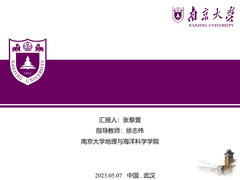报告详情
Carbon isotopic signature of microbial activity during initial soil formation
编号:2511
访问权限:私有
更新:2023-04-21 21:13:02
浏览:565次
快闪报告
摘要
The stable carbon isotopes in soil organic carbon (SOC) undergo fractionation during the enrichment and decomposition processes. While several biochemical processes play a role in SOC enrichment and decomposition, their impact on the fractionation of stable carbon isotopes, particularly during initial soil formation, remains poorly understood. The sand dunes in the southern margin of the Tengger Desert in north-central China have recently stabilized due to vegetation restoration projects, creating the ideal conditions to study stable carbon isotopic fractionation during biological soil crust (BSC) formation. Samples of plant litterfall, BSCs, and subsurface sandy soils were collected from dunes restored at different years, and their SOC content and stable carbon isotope composition were analyzed. The results showed that the SOC content of BSCs and subsurface soils increased steadily since restoration and that there was significant fractionation of the stable carbon isotopes. The δ13C of BSCs rapidly increased with a large variation in the beginning, likely due to microbial activities dominated by cyanobacteria, and were substantially higher than that of subsurface soils. However, after only a few years of restoration, the carbon isotopic composition of BSCs and subsurface soils gradually decreased and approached that of soils under native vegetation. This highlights the critical role of microbial activities in carbon turnover during early soil formation, though the ultimate equilibrium state of SOC content and its carbon isotopic composition is determined by climate conditions.
关键词
drylands; microbial activity; stable carbon isotope; sandy soils; soil organic carbon; BSCs
报告人

张藜萱
南京大学稿件作者
全部评论
重要日期
-
会议日期
05月05日
2023
至05月08日
2023
-
03月31日 2023
初稿截稿日期
-
05月25日 2023
注册截止日期
主办单位
青年地学论坛理事会
中国科学院青年创新促进会地学分会
中国科学院青年创新促进会地学分会
承办单位
武汉大学
中国科学院精密测量科学与技术创新研究院
中国地质大学(武汉)
中国科学院精密测量科学与技术创新研究院
中国地质大学(武汉)



发表评论